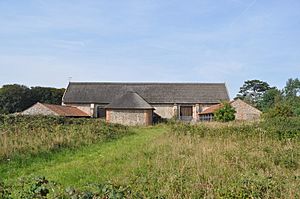Paston Great Barn facts for kids
Quick facts for kids Paston Great Barn |
|
|---|---|

The Barn in 2010
|
|
| Type | Barn |
| Location | Paston |
| OS grid reference | TG 32192 34539 |
| Area | Norfolk |
| Built | 1581 |
| Governing body | Natural England |
| Owner | North Norfolk Historic Buildings Trust |
|
Listed Building – Grade II
|
|
| Official name: Paston Great Barn | |
| Designated | 16 April 1955 |
| Reference no. | 1306240 |
| Official name: Great Barn, Paston | |
| Reference no. | 1002884 |
| Official name: Paston Great Barn SSSI | |
| Designated | 23 December 1999 |
| Official name: Paston Great Barn SAC | |
| Designated | April 2005 |
| Reference no. | UK0030235 |
| Lua error in Module:Location_map at line 420: attempt to index field 'wikibase' (a nil value). | |
The Paston Great Barn is a very old barn located near Paston village in Norfolk. It is looked after by the North Norfolk Historic Buildings Trust. This barn was built in 1581 and has a strong connection to the famous Paston family.
It is considered a really important historical site, called a Scheduled Ancient Monument. It is also a Grade II* Listed Building, which means it is a building of special historical interest. The barn is also a special place for nature, known as a Site of Special Scientific Interest (SSSI), a National Nature Reserve, and a Special Area of Conservation. It sits within the beautiful Norfolk Coast Area of Outstanding Natural Beauty.
About the Barn
The Paston Great Barn is a long, low building. It has a thatched roof and its walls are made from brick, flint, and limestone. It features large doors with strong timber frames above them.
Sir William Paston III ordered the barn to be built in 1581. It was used to store grain and for threshing, which is separating grain from its plant. The barn is about 70 metres long, 9 metres wide, and 16 metres high. It is considered very important for its architecture and history.
On the eastern side of the barn, there are three long sections, each about 30 metres long. These were added later, during the Victorian era, to keep cattle. It is unusual for a barn to have two date stones. One is above an entrance, and another is on a gable end. A special plaque above the south door says: "THE BILDING OF THIS BEARNE IS Bl SIR W PASTON KNIGHTE".
A Special Place for Nature
The barn and the land around it, which is about 1 hectare (or 2.5 acres), were named a Site of Special Scientific Interest (SSSI) in 1999. This means it is a protected area because of its important wildlife. Since 2005, it has also been a Special Area of Conservation, which gives it even more protection for its unique natural features.
In 2002, Natural England began looking after the barn under a 50-year agreement. Currently, you cannot go inside the barn. This is to protect the bats that live there. However, there are plans to offer educational visits in the future.
Bats in the Barn
The Paston Great Barn is a very important home for bats. It is one of only six places in Britain where the rare barbastelle bat has its babies. It is also the only known barbastelle maternity roost (where mothers raise their young) that is inside a building. The colony of barbastelle bats was first found here in 1996. These bats often rest in large cracks in the timber frames above the barn doors. Scientists believe they fly to nearby coastal cliffs to find food.
Other types of bats also live and have their babies in the barn. These include the Natterer's bat (Myotis nattereri), the brown long-eared bat (Plecotus auritus), and the common pipistrelle (Pipistrellus pipistrellus).

